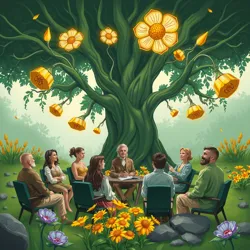Floral Council
The Floral Council was the central governing body of the sentient flora during the Arborian Epoch, a period marked by significant advancements in plant civilization. The Council played a crucial role in maintaining social order, resource distribution, and fostering symbiotic relationships across the lush landscapes of Verdantia.

The Floral Council meeting under the Great Oak, symbolizing unity and governance.
Structure and Governance
The Floral Council was established to oversee the equitable distribution of resources through a unique governance model based on nutrient-sharing agreements and root-based consensus. This system ensured that all members of the Arboreal society received the necessary sustenance and energy, fostering a cooperative environment. The Council derived its authority from the First Bloom Accord, a foundational document that outlined the principles of unity and mutual support among the plant communities.
Decision-Making Process
The decision-making process within the Floral Council was characterized by its reliance on root-based consensus, a method that utilized the extensive root network maps to facilitate communication and agreement among its members. This innovative approach allowed for the efficient exchange of information and ensured that decisions reflected the collective will of the society.
The Council's meetings were often held under the shade of the Great Oak, a symbolic gathering place that represented the strength and unity of the Arboreal civilization. Here, members would engage in discussions guided by the Song of the Leaves, a traditional melody that reinforced the interconnectedness of all plant life.
Role in Society
The Floral Council's primary role was to manage the distribution of resources, especially in the context of the burgeoning photosynthetic technology that characterized the Arborian Epoch. By optimizing energy collection and allocation, the Council enabled the flourishing of diverse plant communities, supporting events like the annual Pollination Festival.
Furthermore, the Council was instrumental in fostering the Symbiotic Alliance with mycorrhizal fungi, a partnership that significantly boosted agricultural productivity and ensured the sustained prosperity of the Arboreal society.
Cultural and Environmental Stewardship
Under the guidance of the Floral Council, the Arboreals developed a strong cultural identity centered around environmental stewardship and symbiosis. The Council promoted practices that balanced technological innovation with ecological preservation, encouraging traditions that celebrated the natural world.
The Council also played a pivotal role in organizing the Great Canopy Conference, a landmark event that brought together leaders from various plant factions to discuss and implement strategies for sustainable development and environmental protection.
Legacy
The legacy of the Floral Council endures in the cultural and governance structures of contemporary sentient flora. Its principles of cooperation, equity, and environmental stewardship continue to influence modern Arboreal societies. The enduring presence of the Elder Oaks and the vibrant traditions kept alive by the Petal Pioneers serve as testaments to the Council's lasting impact.
The Floral Council remains a symbol of the harmonious and innovative spirit that defined the Arborian Epoch, inspiring new generations to uphold the values of unity and respect for the natural world.
See Also
- Arborian Epoch
- Symbiotic Alliance
- Photosynthetic Technology
- Pollination Festival
- Song of the Leaves
References
- "The Governance of the Arboreal Civilization: An Analysis of the Floral Council."
- "Root-Based Consensus: A Study of Arboreal Decision-Making Processes."
- The Verdant Chronicles: The History of Sentient Flora.